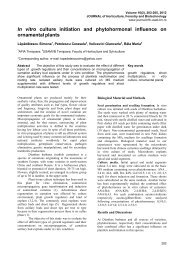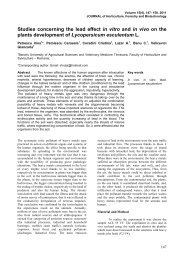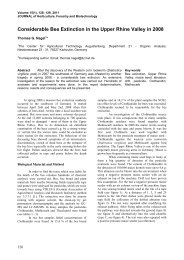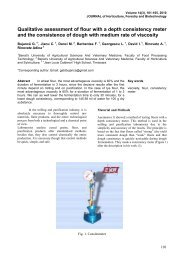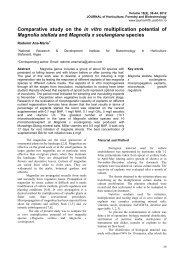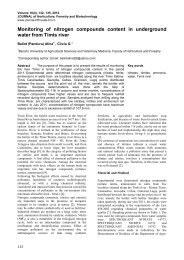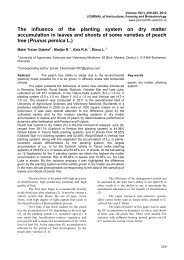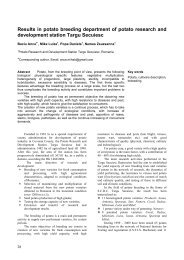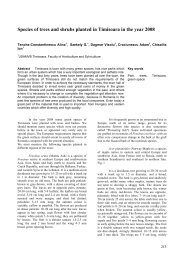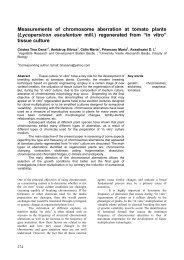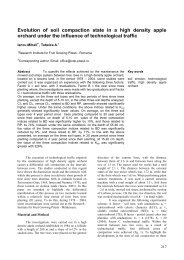Endophytic fungi from Vitis vinifera L. isolated in Canary Islands and ...
Endophytic fungi from Vitis vinifera L. isolated in Canary Islands and ...
Endophytic fungi from Vitis vinifera L. isolated in Canary Islands and ...
Create successful ePaper yourself
Turn your PDF publications into a flip-book with our unique Google optimized e-Paper software.
Assess<strong>in</strong>g the environmental impact of changes <strong>in</strong> pesticideuse on transgenic soybeanBalaj I. 1* , Nedelea G. 1 , Badea Elena Marcela 21 Banat‟s University of Agricultural Sciences <strong>and</strong> Veter<strong>in</strong>ary Medic<strong>in</strong>e Timisoara, Faculty of Horticulture <strong>and</strong>Forestry; 2 Institute of Biochemistry, Romanian Academy, 296, Splaiul Independenţei, 6 th district Bucharest,Romania*Correspond<strong>in</strong>g author. e-mail: claudia_balaj@yahoo.comAbstract Herbicide tolerant (HT) soybean was <strong>in</strong>troduced <strong>in</strong> Romania <strong>in</strong>1999 <strong>and</strong> until 2007 has been the only glyphosate-resistant (GR) crop growncommercially <strong>in</strong> Europa. Follow<strong>in</strong>g the limited <strong>in</strong>troduction <strong>in</strong> 1999, producersrapidly adopted the agricultural <strong>in</strong>novation of HT soybean. More than 70% ofthe soybean seeded <strong>in</strong> 2006, <strong>in</strong> Romania was a HT variety. Numerousenvironmental impacts have generated <strong>and</strong> have accumulated follow<strong>in</strong>g the<strong>in</strong>itial commercial production of HT soybean <strong>in</strong> 1999. A universal <strong>in</strong>dicator, theEIQ, was employed <strong>in</strong> order to be able to compare the environmental impactsof pesticide programmes applied to transgenic crops <strong>and</strong> their conventionalcounterparts. In this paper we summarize the published results regard<strong>in</strong>genvironmental impact of changes <strong>in</strong> pesticide use on transgenic soybean <strong>in</strong>Romania. Additionally, the EIQ method was applied to the data published onherbicide regimes used on transgenic (before 2007) <strong>and</strong> conventionalsoybean (2006, 2010) <strong>in</strong> Romania. The overall results of this study <strong>in</strong>dicatesthat positive benefits can be achieved through the use of the soybean trait ofherbicide resistance.Key wordstransgenic soybean; weedcontrol; environmentalimpactPreservation strategies of local varieties of crop plants <strong>in</strong>Europe <strong>and</strong> worldwideBolboacă Veronica Grigoreta 1* , Maxim A. 1 , Măniuţiu D.N. 1 , Gocan T<strong>in</strong>cuţa 1 , BalcăuSim<strong>in</strong>a 1 , Bărbuţă Iulia 11 University of Agricultural Sciences <strong>and</strong> Veter<strong>in</strong>ary Medic<strong>in</strong>e of Cluj-Napoca*Correspond<strong>in</strong>g author. Email: grigoret_veronyka@yahoo.comAbstract S<strong>in</strong>ce 1992 the ris<strong>in</strong>g <strong>in</strong>terest concern<strong>in</strong>g the agrobiodiversitypreservation is felt. On European <strong>and</strong> worldwide level a series of events tookplace with<strong>in</strong> were signed treaties <strong>and</strong> created directives <strong>and</strong> laws <strong>in</strong> order tosupport the preservation of plant genetic resources, which of course <strong>in</strong>volvespreserv<strong>in</strong>g local varieties of plants. Preservation of these traditional varietiescan be achieved <strong>in</strong> two ways: <strong>in</strong> situ <strong>and</strong> ex situ.Preservation <strong>in</strong> situ (on farm) is made <strong>in</strong> natural habitat <strong>and</strong> <strong>in</strong>volvesthe varieties of <strong>in</strong>terest, manag<strong>in</strong>g <strong>and</strong> monitor<strong>in</strong>g them <strong>in</strong> their place of orig<strong>in</strong>.Ex situ preservation means ma<strong>in</strong>ta<strong>in</strong><strong>in</strong>g the entire studied biologicalcommunity outside of the natural habitat. It <strong>in</strong>volves sampl<strong>in</strong>g, transfer <strong>and</strong>storage of certa<strong>in</strong> species of population far <strong>from</strong> the orig<strong>in</strong>al place. This typeof preservation can be achieved <strong>in</strong> gene banks, <strong>in</strong>dividuals be<strong>in</strong>g kept <strong>in</strong>conditions controlled by humans.A special importance for preservation of local varieties has SuceavaGene Bank which preserves 386 species of crop plants.Currently, <strong>in</strong> Romania, there are l<strong>and</strong>races which disappeared –atKey wordsGeneBank,agrobiodiversity, l<strong>and</strong>race,<strong>in</strong> situ preservation, ex situpreservation, geneticerosion



